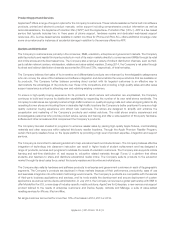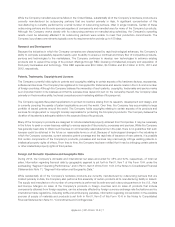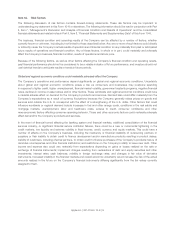Apple 2014 Annual Report Download - page 16
Download and view the complete annual report
Please find page 16 of the 2014 Apple annual report below. You can navigate through the pages in the report by either clicking on the pages listed below, or by using the keyword search tool below to find specific information within the annual report.The Company could be impacted by unfavorable results of legal proceedings, such as being found to have infringed on
intellectual property rights.
The Company is subject to various legal proceedings and claims that have not yet been fully resolved and that have arisen in
the ordinary course of business, and additional claims may arise in the future.
For example, technology companies, including many of the Company’s competitors, frequently enter into litigation based on
allegations of patent infringement or other violations of intellectual property rights. In addition, patent holding companies seek to
monetize patents they have purchased or otherwise obtained. As the Company has grown, the intellectual property rights
claims against it have increased and may continue to increase. In particular, the Company’s cellular enabled products compete
with mobile communication and media device companies that hold significant patent portfolios, and the number of patent
claims against the Company has significantly increased. The Company is vigorously defending infringement actions in courts in
a number of U.S. jurisdictions and before the U.S. International Trade Commission, as well as internationally in various
countries. The plaintiffs in these actions frequently seek injunctions and substantial damages.
Regardless of the scope or validity of such patents or other intellectual property rights, or the merits of any claims by potential
or actual litigants, the Company may have to engage in protracted litigation. If the Company is found to infringe one or more
patents or other intellectual property rights, regardless of whether it can develop non-infringing technology, it may be required
to pay substantial damages or royalties to a third-party, or it may be subject to a temporary or permanent injunction prohibiting
the Company from marketing or selling certain products.
In certain cases, the Company may consider the desirability of entering into licensing agreements, although no assurance can
be given that such licenses can be obtained on acceptable terms or that litigation will not occur. These licenses may also
significantly increase the Company’s operating expenses.
Regardless of the merit of particular claims, litigation may be expensive, time-consuming, disruptive to the Company’s
operations and distracting to management. In recognition of these considerations, the Company may enter into arrangements
to settle litigation.
In management’s opinion, there is not at least a reasonable possibility the Company may have incurred a material loss, or a
material loss in excess of a recorded accrual, with respect to loss contingencies, including matters related to infringement of
intellectual property rights. However, the outcome of litigation is inherently uncertain.
Although management considers the likelihood of such an outcome to be remote, if one or more legal matters were resolved
against the Company in a reporting period for amounts in excess of management’s expectations, the Company’s consolidated
financial statements for that reporting period could be materially adversely affected. Further, such an outcome could result in
significant compensatory, punitive or trebled monetary damages, disgorgement of revenue or profits, remedial corporate
measures or injunctive relief against the Company that could materially adversely affect its financial condition and operating
results.
The Company is subject to laws and regulations worldwide, changes to which could increase the Company’s costs and
individually or in the aggregate adversely affect the Company’s business.
The Company is subject to laws and regulations affecting its domestic and international operations in a number of areas. These
U.S. and foreign laws and regulations affect the Company’s activities including, but not limited to, in areas of labor, advertising,
digital content, consumer protection, real estate, billing, e-commerce, promotions, quality of services, telecommunications,
mobile communications and media, television, intellectual property ownership and infringement, tax, import and export
requirements, anti-corruption, foreign exchange controls and cash repatriation restrictions, data privacy requirements, anti-
competition, environmental, health and safety.
Apple Inc. | 2014 Form 10-K | 14
























